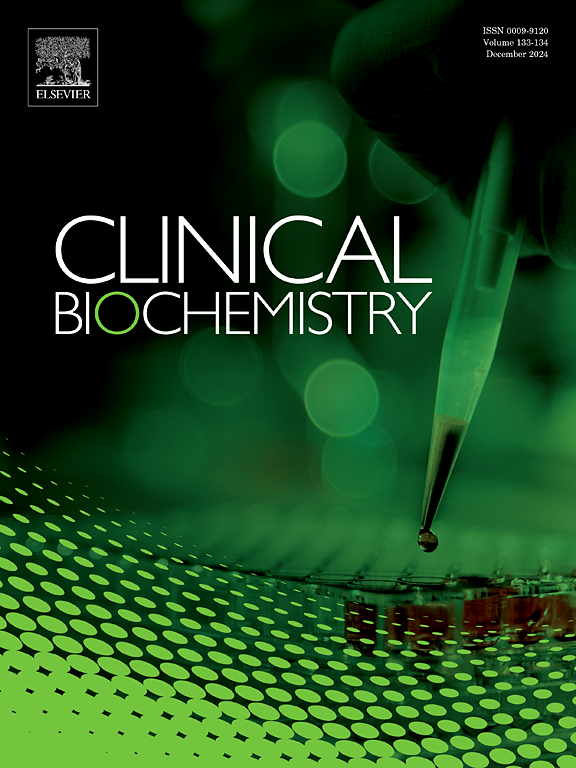Multi-institution comparison of whole blood potassium hemolysis rates
IF 2.1
3区 医学
Q2 MEDICAL LABORATORY TECHNOLOGY
引用次数: 0
Abstract
Introduction
Hemolysis causes falsely elevated potassium results and if undetected, can lead to misidentification of hypokalemia or hyperkalemia causing delayed or inappropriate treatment. The prevalence of hemolysis in whole blood samples submitted for potassium or blood gas analysis remains unknown due to historical limitations in blood gas analyzer hemolysis detection. This study aimed to compare hemolysis rates in whole blood potassium samples measured by blood gas analyzers at four different academic medical centers. Further, we compared rates among differing blood sources and hospital settings, and potassium results among different hemolysis flags.
Materials and methods
Potassium results and hemolysis flags measured on the GEM Premier 7000 at four different academic medical centers were compiled for six months at each location.
Results
A total of 37,944 samples with hemolysis flags were obtained from four academic medical centers with an overall hemolysis rate of 10.0 % (hemolysis flags corresponding to > 50 mg/dL plasma free hemoglobin). Hemolysis rates varied by institution ranging from 9.2-14.6 %. Hemolysis rates were similar between arterial (8.6 %) and venous (10.6 %) samples but were substantially higher for capillary (17.7 %) samples. Samples collected in the emergency department showed greater hemolysis rates (17 %) compared to those samples originating in intensive care units (8.1 %) and all other (10.2 %) departments.
Conclusions
This study demonstrates high hemolysis rates for whole blood potassium samples measured by blood gas analyzers, particularly for the emergency department setting and capillary specimens. This study demonstrates the importance of hemolysis detection for improving laboratory quality and patient safety.
多机构全血钾溶血率比较
溶血导致错误的钾升高结果,如果未被发现,可能导致误认低钾血症或高钾血症,导致延迟或不适当的治疗。由于血气分析仪溶血检测的历史局限性,溶血在提交钾或血气分析的全血样本中的流行程度仍然未知。本研究旨在比较四个不同学术医疗中心的血气分析仪测量的全血钾样本的溶血率。此外,我们比较了不同血液来源和医院环境的比率,以及不同溶血标志的钾结果。材料和方法在四个不同的学术医疗中心,对GEM Premier 7000在每个地点测量的六个月的钾含量结果和溶血标志进行汇总。结果4个学术医疗中心共采集溶血标志标本37944份,溶血率10.0%(溶血标志对应的溶血标志为>;血浆游离血红蛋白50mg /dL)。溶血率因机构而异,从9.2- 14.6%不等。动脉(8.6%)和静脉(10.6%)样品的溶血率相似,但毛细血管样品的溶血率高得多(17.7%)。与来自重症监护病房(8.1%)和所有其他科室(10.2%)的样本相比,在急诊科收集的样本显示更高的溶血率(17%)。结论:本研究表明,血气分析仪测量的全血钾样本具有较高的溶血率,特别是急诊科环境和毛细血管样本。本研究表明溶血检测对提高实验室质量和患者安全的重要性。
本文章由计算机程序翻译,如有差异,请以英文原文为准。
求助全文
约1分钟内获得全文
求助全文
来源期刊

Clinical biochemistry
医学-医学实验技术
CiteScore
5.10
自引率
0.00%
发文量
151
审稿时长
25 days
期刊介绍:
Clinical Biochemistry publishes articles relating to clinical chemistry, molecular biology and genetics, therapeutic drug monitoring and toxicology, laboratory immunology and laboratory medicine in general, with the focus on analytical and clinical investigation of laboratory tests in humans used for diagnosis, prognosis, treatment and therapy, and monitoring of disease.
 求助内容:
求助内容: 应助结果提醒方式:
应助结果提醒方式:


